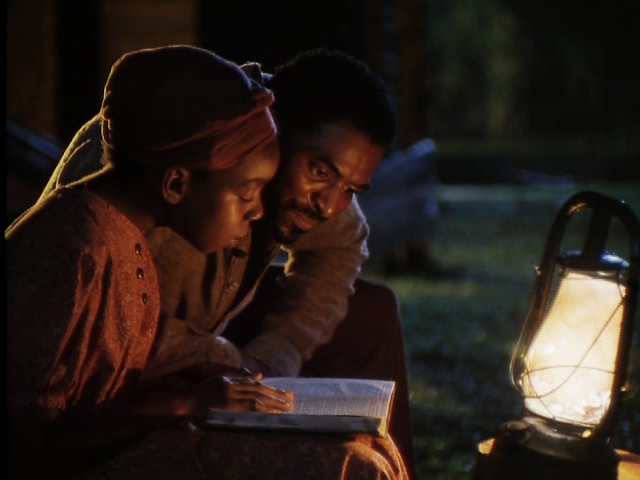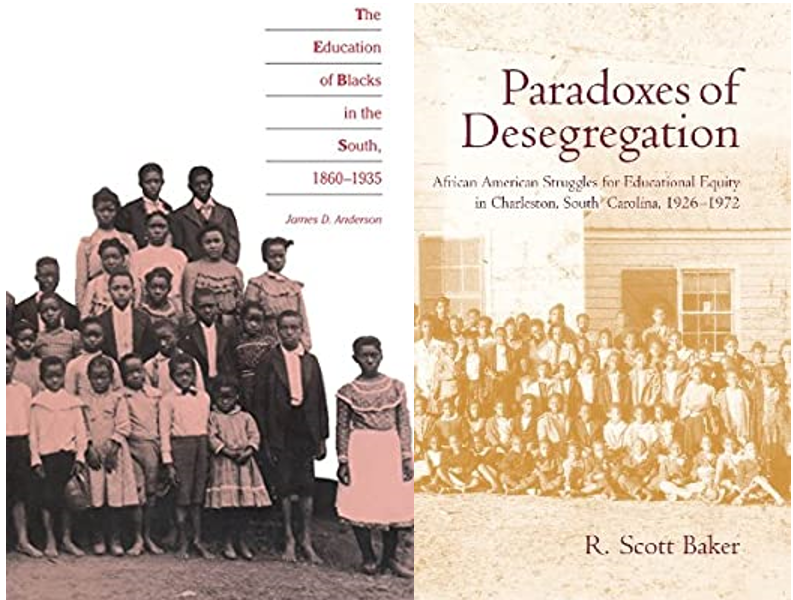Throughout history, African Americans have seen education as “a way to break out of the unbreakable cycle” (Anderson, pg. 92) of oppression that has encompassed their existence since the inception of the United States. The sacredness in which they held education reveals a central theme of sacrifice in hopes of having a brighter tomorrow. In particular, they continually sacrificed their physical, mental, and financial well-being in the eternal struggle for a more humanized world.
Physical Sacrifices: Violent Backlash in the Struggle for Education and Equality

Obtained from https://mcgensymovies.wordpress.com/2014/02/25/nightjohn-knowledge-is-power/
Throughout history, African Americans have experienced violence as the visceral response in their quest for education. Slaves were forbidden from learning to read or write and faced severe beatings and even death if they were caught doing so. This is somberly portrayed in the 1996 film Nightjohn, where John, a former runaway slave, teaches a young 12-year-old Sarny to read. Upon learning that John can read, the masters brutally whip him and dismember one of his fingers. Although John suffers immense physical pain, it is through his sacrifice that Sarny uses her newfound ability to read to lift the veil of control that the slave owners held over them (Burnett, C. (1996) Nightjohn USA).
Nearly 100 years after the abolition of slavery, educational equality made progress in the courts, yet violence remained a staple of being Black in the United States. One year after the monumental Brown v. Board of Education, Emmett Till, a 14-year-old Black boy was lynched for allegedly flirting with a White woman at a grocery store in Mississippi. To demonstrate the violence that African American’s were experiencing for no other reason than being black, Mamie Till, Emmett’s mother, opted for an open casket of her son, which displayed a figure beaten beyond recognition. The image of the open casket was seen by those attending the funeral and thousands of others who saw the gruesome photos as they were published across Black media outlets. The trend of using media to capture the widespread violence that was being inflicted on African American’s propelled the civil rights era to a mass movement (Ava Duvernay & Jason Moran. (2016) 13TH. USA).
- Emmet Till’s mother grieves over her sons open casket in 1955 retrieved from https://www.theguardian.com/us-news/2019/oct/20/emmett-till-new-memorial-bulletproof
- A woman in Illinois being forcibly removed from protesting in 1968 Retrieved from https://www.theatlantic.com/photo/2014/05/1964-civil-rights-battles/100744/
- The Orangeburg Massacre at SC state in 1968 retrieved from https://www.history.com/topics/1960s/orangeburg-massacre
Emotional Sacrifices
In addition to the physical violence that African American’s have endured, they also have experienced emotional violence as they fought for educational opportunities. John Wrighten, a South Carolina native, and an aspiring lawyer was represented by the NAACP in multiple blockbuster legal actions that would break the segregation barrier in the South. His bravery was repaid with the exclusion of financial stability and entry into the job market. As Wrigthen himself put it, “Every time I go to get a job with a white person, and they find out that I am John H. Wrighten nothing.” (Baker pg. 81).
In addition to excluding them from the status quo, sometimes Blacks fighting for education were ostracized from their own communities as well. Gwendolyn Robinson was a scholarship student at Spelman College during the civil rights era, who was determined to focus on grades instead of getting involved in protests. Despite her best efforts, she soon found herself picketing which landed her in jail. When word of her imprisonment reached Robinson’s grandmother, she told her that she had brought shame to her entire family as she was the first person in their family to attend jail (Collins, pg. 112-113).

Septima Clark was a civil rights hero and Charleston school teacher who was a staunch advocate of the NAACP. Septima bravely refused to deny her affiliation with the NAACP, which resulted in her termination. Her outspokenness and belief in civil rights often time put her at odds with her family, as they felt she was risking too much and it would be best to simply keep their heads down and avoid conflict (Septima Clark, pg.164).
Arguably the most traumatic emotional experiences were those from African American Students who were among the first to integrate into White schools. Students felt isolation and ostracization from their communities as they found themselves in an unwelcome and hostile environment. The trauma that these trailblazers endured plagued them the rest of their lives (Baker 163, Eyes on the Prize II ).
Financial Sacrifices

Even as African Americans were largely excluded from the financial benefits and opportunities that accompanied Whites, they still demonstrated a consistent pattern of sacrificing their finances for a chance of education to be instilled in their communities. White school authorities directed taxes overwhelmingly to assist White public education while simultaneously excluding Black students, Black southerners self-imposed a double taxation to have money to fund the Rosenwald schools, which were funded in part due to philanthropy (Anderson pg. 156).
Double taxation wasn’t the only financial sacrifice made by Black southerners. As communities strategized how to financially support local schools, some gave their life savings to see a school built where they lived. Even when community members had virtually no money to give, they donated labor, land, and materials to ensure their community would have a local school (Anderson pg. 165).
The financial sacrifices established in the twilight of the reconstruction era remained constant later into the century. In 1963, during the youth-led vanguard of the civil rights movement, Charleston adults put their houses up for collateral to raise more than $1.4 million (nearly $12 million by 2020 standards) needed to bail out protesters who were imprisoned during civil rights demonstrations (Baker pg.152-153).

As this illustration about the sacrifices that African American’s have made in their struggle for education closes, it is important to remember that these are just a few of the examples that our brothers and sisters have endured throughout the years. It is impossible to fully capture just how selfless they have been in their fight to see a brighter tomorrow.
The brighter tomorrow that our heroes dreamed of has suddenly become today, yet there are still a plethora of inequalities facing Black students in 2020. As we reflect on the sacrifices they have made, let us consider the sacrifices that we can make in the struggle for equality of all living beings. As Reverend King infamously said-

Sources
Ava Duvernay & Jason Moran. (2016) 13TH. USA.
Anderson, J. D. (1988). The education of Blacks in the South, 1860-1935. Univ of North Carolina Press.
Baker, R. S. (2006). Paradoxes of desegregation: African American struggles for educational equity in Charleston, South Carolina, 1926-1972. Univ of South Carolina Press.
Burnett, C. (1996). Nightjohn. USA.
Clark, S. P. (1990). Ready from Within: Septima Clark and the Civil Rights Movement. Africa World Press.
Collins, G. (2009). When everything changed: The amazing journey of American women from 1960 to the present. Little, Brown.
Hampton, H. (2006). Eyes on the prize. USA.



